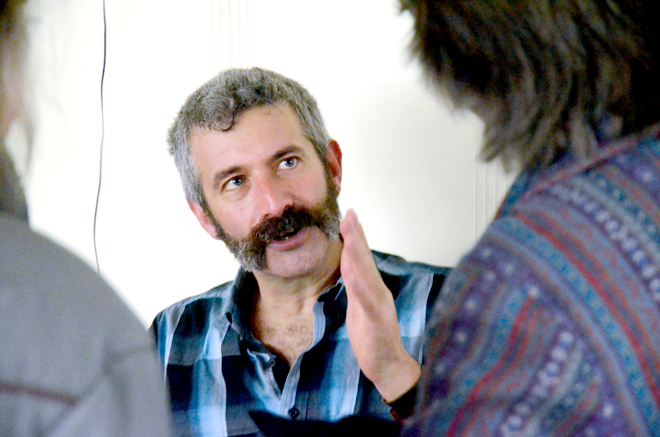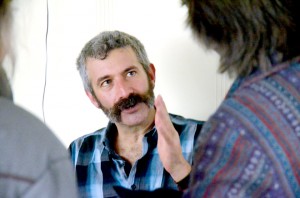

by Joseph Gresser
copyright the Chronicle 4-10-2013
CRAFTSBURY COMMON — A self-proclaimed “fermentation evangelist” preached the gospel of sauerkraut March 3 to a receptive congregation at Sterling College.
Sandor Katz has gained wide recognition for writing and teaching about different types of fermented foods. But his talk at Sterling followed his most recent book The Art of Fermentation on a more philosophical exploration of a method of food transformation that is practiced in one way or another by every culture.
The word culture itself is central to Mr. Katz’s new book and also to his talk. He noted the use of the word to indicate the specific microorganisms that are introduced to milk to make yogurt and particular varieties of cheese, as well as its common meaning, denoting a collection of activities, beliefs and artistic practices that are the hallmarks of a human society.
In Mr. Katz’s view, a culinary culture is, in part, made up of the microorganisms that help create foods and drinks that characterize a society. We consume many of these without giving much thought to their origins.
Beer, wine, bread, cheese, coffee, pickles, cured meats are all foods that rely on fermentation, a process that, in turn relies on a healthy society of microorganisms.
Mr. Katz said he has tried to find societies that do not use the process of fermentation to preserve foods or create dishes of extraordinary flavor. So far, he said, he has failed to discover one.
The key to fermentation, he said, is the world of microorganisms that have evolved along with humanity. In his book, Mr. Katz says that previous generations depicted these microorganisms as humanity’s tiny servants, working tirelessly to transform milk into cheese or grain into beer.
Another way of viewing the situation, he said, is to see these creatures as having tricked humans into working hard to provide a nice comfortable environment in which they can grow and reproduce, by producing flavors that we enjoy.
After the French scientist, Louis Pasteur, discovered the relationship between bacteria and disease, humanity’s relationship with these creatures has undergone a radical change, Mr. Katz said.
“All of us raised in the United States in the twentieth century have been indoctrinated to consider bacteria as bad,” Mr. Katz told more than 100 students, teachers and community members.
He said the current craze for soaps that kill up to 99 percent of all bacteria is a mistake, especially when our own bodies are mostly made up of bacteria.
Mr. Katz said research shows that bacteria outnumber human cells by ten to one in our bodies. “We are host to them,” he remarked, “but maybe they are host to us.”
These bacteria are not parasites, Mr. Katz said. They do things for us that we could not do without them, and contribute to processes as vital to our survival as digestion and reproduction.
Coexistence with these microorganisms is imperative, Mr. Katz said.
As a person who has conducted thousands of workshops to teach people how to make sauerkraut and similar foods, Mr. Katz said he has found many people who worry about the danger of getting the wrong kind of bacteria in their fermented foods.
Fermented foods made with raw vegetables are very safe, he said, although “more parameters for safety need to be followed when working with meat or milk.
“The number of reported fatalities from eating fermented vegetables, according to the U.S. Department of Agriculture is,” Mr. Katz paused for emphasis here, “exactly zero.”
He continued, saying, “Once cabbage is chopped, salted and fermented in its own juice, natural bacteria take over, acidifying the environment and destroying invading bacteria.”
That process is one in which a group of bacteria create a stable environment for themselves, Mr. Katz said. Such a culture, propagated by the process of back-slopping — adding a portion of one batch of the ferment to milk or grains to create the next batch — can last for generations, he said.
Yogurt and sourdough cultures can last for years if tended carefully, he said.
Industrially produced ferments, such as commercial yogurt, generally rely on specific microorganisms purchased from catalogs, Mr. Katz said. These produce uniform results, but do not do well in the wild.
He told of how he tried for years to make yogurt by adding some commercial yogurt to warm milk. The first batch, he said, was satisfying with the flavor and texture he craved.
Each succeeding generation was less successful, he said. The specialized cultures purchased by the commercial yogurt makers were not able to ward off wild microorganisms and so deteriorated over time, he said.
In contrast yogurt made from wild strains in the Balkans can be cultured by back-slopping indefinitely, he said, because the culture is made up of a variety of organisms that work together to ward off invading bacteria.
In his talk, as in his book, Mr. Katz equates the cooperative interaction of the wild microorganism with people learning and teaching about fermented foods, and even experimenting with new foods, to create a culture apart from the large-scale commercial food industry.
In his book he explores the different ways people have learned to preserve foods as diverse as fish, grains and casava roots with the assistance of microorganisms.
He gives the loosest types of recipes to make most of these foods, but most importantly Mr. Katz gives encouragement and even permission to those who are on the brink of entering the world of ferments.
Mr. Katz’s talk was the first in a series sponsored by Sterling College and the Galaxy Bookshop in Hardwick that they say is designed to bring “contemporary perspectives and visionary speakers on local and global food systems to the Northeast Kingdom of Vermont.”
During his stay Mr. Katz got to see the work on local food systems that has developed here over the past few years. In turn he provided an overview of a global system that predates, and will likely outlast, humanity.
The Art of Fermentation, by Sandor Ellix Katz. Published by Chelsea Green Publishing, White River Junction, 2012, 498 pages, hardcover, $39.95.







